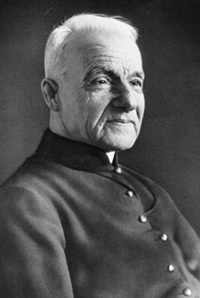
Blessed Brother André Bessette, C.S.C., will be canonized, or formally declared a saint, in a ceremony to be held Oct. 17.
Pope Benedict XVI announced the decision to canonize Brother André following a meeting of cardinals in Vatican City today.
Blessed Brother André was a brother of the Congregation of Holy Cross, the religious order which founded the University of Notre Dame, and the founder of St. Joseph’s Oratory of Mount Royal in Montreal.
“All of us in the Notre Dame family are delighted to hear of Brother André’s canonization” said Notre Dame president Rev. John I. Jenkins, C.S.C. “His brothers in Holy Cross founded Notre Dame three years before he was born and continue to teach and serve here today, determined not only to educate minds and hearts, but to give witness to the kingdom of God. Brother André’s life, now recognized as a true treasure of the church, and his continuing advocacy, renew, deepen, and strengthen our foundational mission.”
Born Alfred Bessette on Aug. 9, 1845, in Saint-Gregoire d’Iberville, Quebec, Brother André was one of 12 children. By the time he was 12 years old, his father, a lumberman, had been killed in a work accident and his mother had died of tuberculosis. Physically diminutive, chronically ill, uneducated and clumsy with his hands, the young Bessette nevertheless worked as a farmhand, shoemaker, baker, and blacksmith in Quebec for six years before leaving for New England, where he spent four years working in textile factories and farms in Connecticut, Massachusetts and Rhode Island.
From his earliest childhood, he was quietly but conspicuously prayerful, an inclination which seemed only to intensify during his hardscrabble years as an itinerant laborer, and when he returned to Canada in 1867, he confessed an interest in formal religious life to his local parish priest, who sent him to a nearby community of Holy Cross brothers with a letter assuring its superior that “I am sending you a saint.”
The largely illiterate 25-year old novice was put to work as a porter, or doorman, at Montreal’s College of Notre Dame, an assignment in which he continued for the next 40 years.
In addition to welcoming visitors, he served as janitor, launderer, and sacristan, ran errands and provided the students with cheap haircuts. Throughout these years his reputation for humility and kindness grew, as did the numbers of visitors he received. Most of these were poor and sick people, to whom he offered not only his compassion and what material assistance he could provide, but also moral and spiritual advice. Many of his visitors attributed miraculous cures to him, but he would insist, sometimes with annoyance, that any such cures were attributable to the prayers of Saint Joseph.
Brother André’s particular affection for St. Joseph, in addition to the need to accommodate the throngs of people seeking his help, advice and prayers, led to the foundation of Saint Joseph’s Oratory, at first a small structure constructed on Mount Royal with funds from small donations and Brother André’s barbershop income and now a massive basilica which attracts some 2 million pilgrims each year.
Brother André was entombed there after his death on Jan. 6, 1937. Between his death and burial, more than 1 million pilgrims came to pay tribute.
“We are honored and moved beyond words at Brother André’s formal recognition as a saint,” said Rev. David Tyson, C.S.C., Provincial Superior of the Indiana Province of Holy Cross. “Not only because this immensely humble man is the Congregation’s first recognized saint, but because he is such an extraordinary example for every Catholic of every age. Not for him the trappings of power and status, of money and prestige; he was famous first as a ferociously hard worker at the high school where he worked his whole life; he simply did everything and anything that was needed, from cleaning the floors to fixing shoes, from doing students’ laundry to cutting hair. What an example of prayer in action, of active service to others as the most eloquent and powerful prayer of all! And that is the essence of the Congregation – we serve the Christ in every being, with our hands and hearts and souls, with all our might. Brother André would be horrified were I to call him a hero, but his unrelenting focus on serving others, his blunt humor and utter devotion to God, the greatness of his simplicity – those are heroic virtues, and it seems wonderfully apt and instructive that the first Holy Cross saint was a man who insisted, sometimes testily, that ‘to serve is sweeter than to be served.”
Not only among the priests, sisters and brothers of the Congregation of Holy Cross, but also throughout the Notre Dame community, the new saint is affectionately regarded, conspicuously honored and continually invoked. He is routinely mentioned in campus liturgies, and his statue, carved by Rev. Anthony J. Lauck, C.S.C., is in the northeast apsidal chapel of Notre Dame’s Basilica of the Sacred Heart. Another statue of Brother André, this one carved by Notre Dame art professor Rev. James F. Flanigan, C.S.C., is above the south entrance of the University’s Eck Visitors Center.